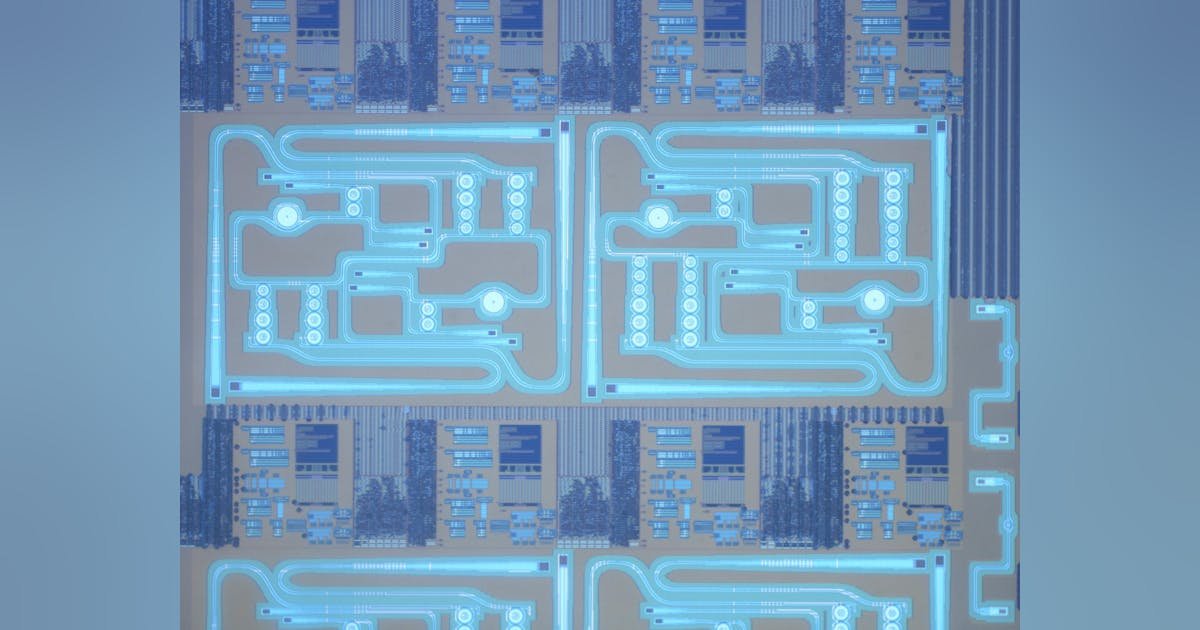Prototype quantum networks, pluggable fiber-optic quantum comms modules ahead
Photon pairs produced by the group’s devices are ready to build prototype quantum networks for distributing quantum information.
“We use a 1550-nm wavelength compatible with existing long-haul fiber infrastructure, and Professor Kumar’s group at Northwestern recently showed that quantum and classical signals can coexist on the same fiber via a quantum teleportation experiment,”1 says Kramnik. “Today, these networks are primarily used for research purposes to develop the communications infrastructure we’ll need in the future once useful quantum computers are ready.”
Another more immediate application is a pluggable fiber-optic quantum communication module based on the group’s chip for a quantum-secured network. “You can imagine certain government organizations and businesses would like to have laptops with 100% secure internet communications that can’t be snooped on like Wi-Fi or even Ethernet—a direct quantum connection to the end device through a fiber that attaches to a silicon-photonic chip would be one way to ensure it—even if you don’t own the fiber,” Kramnik says. “This may require further work on integrating III-V pump lasers and room temperature single-photon detectors onto the same chip, which have already been demonstrated in CMOS-compatible forms elsewhere.”
In the longer term, the group’s platform can be used to build large numbers of heralded single-photon sources needed for photonic quantum computers, such as the ones being pioneered by PsiQuantum and Xanadu.
“I’ve heard people say quantum technology is a solution looking for a problem,” says Wang. “The funny thing is the phrase ‘solution looking for a problem’ comes from a publication in 1964 describing the invention of the laser.2 Fast forward 60 years later, and lasers are used everywhere. A key to unlocking the potential of lasers was scaling their production. Now we have the ability to scale quantum light sources, and I’m really excited to find out what it enables for quantum tech.”
What’s next? Functionality
Not surprisingly, the group is already working on getting more functionality out of their chips. They recently published an OFC conference paper about using their photon-pair source to characterize timing drift within buried underground telecom fiber around the Chicago area.
“This study, surprisingly, shows that underground fiber over a long distance has less drift than a spool of fiber within the lab, which we attribute to the temperature being stabilized underground and any fluctuations (temperature, strain, etc.) being averaged out over the distance of the fiber—whereas the whole fiber is subject to the same variations when it’s concentrated in a spool in the lab,” says Ramesh.
Clearly, these quantum photon sources are already proving useful for engineering and science research for quantum networks. Chicago is a major hub of quantum internet research, and the group is “working on quantum interference experiments between multiple of our CMOS chips to show they can be used to create quantum entanglement between heralded single photons necessary for quantum information processing and networking. We also have a set of next-gen CMOS chips with improved photon-pair generation rate and more parts of the system integrated on the same chip we’re working on bringing up,” says Kramnik.
“Very-large-scale integration (VLSI) silicon photonics—with hundreds and thousands of photonic components tightly integrated with electronics—is now the focus of major industry efforts aimed at transitioning it into volume production, driven primarily by the needs of optical interconnects for AI hardware,” says Popović, who cofounded optical interconnect startup Ayar Labs in 2015 with Stojanović and several other current and former team members. “Quantum systems are even more sensitive and loss-bound than interconnects, so tapping into this industrial momentum is an opportunity to fast-track the development of larger quantum optical systems.”
Support for this work was provided by the National Science Foundation, including its Future of Semiconductors (FuSe) program, the Packard Fellowship for Science and Engineering, and the Catalyst Foundation, as well as Ayar Labs and GlobalFoundries.
FURTHER READING
D. Kramnik et al., Nat. Electron., 8, 620–630 (2025); https://doi.org/10.1038/s41928-025-01410-5.
REFERENCES
1. J. M. Thomas et al., Optica, 11, 1700-1707 (2024); https://doi.org/10.1364/optica.5403622.
2. C. S. Porter, “U.S. Army role in laser development, future potential discussed,” Army R&D News Magazine, 10 (Dec. 1964).

